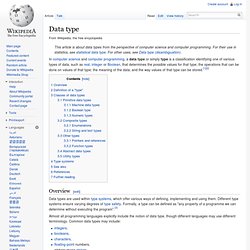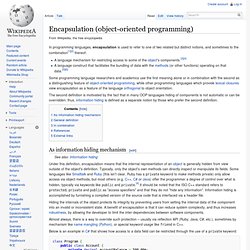

Future Data Architecture Note. New data paradigm. Biological networks. Nature running on DNA. Intelligence amplification. Intelligence amplification (IA) (also referred to as cognitive augmentation and machine augmented intelligence) refers to the effective use of information technology in augmenting human intelligence.

The idea was first proposed in the 1950s and 1960s by cybernetics and early computer pioneers. IA is sometimes contrasted with AI (Artificial Intelligence), that is, the project of building a human-like intelligence in the form of an autonomous technological system such as a computer or robot. AI has encountered many fundamental obstacles, practical as well as theoretical, which for IA seem moot, as it needs technology merely as an extra support for an autonomous intelligence that has already proven to function. Moreover, IA has a long history of success, since all forms of information technology, from the abacus to writing to the Internet, have been developed basically to extend the information processing capabilities of the human mind (see extended mind and distributed cognition). ..
" J. Artificial intelligence. AI research is highly technical and specialized, and is deeply divided into subfields that often fail to communicate with each other.[5] Some of the division is due to social and cultural factors: subfields have grown up around particular institutions and the work of individual researchers.

AI research is also divided by several technical issues. Some subfields focus on the solution of specific problems. Others focus on one of several possible approaches or on the use of a particular tool or towards the accomplishment of particular applications. The central problems (or goals) of AI research include reasoning, knowledge, planning, learning, natural language processing (communication), perception and the ability to move and manipulate objects.[6] General intelligence is still among the field's long-term goals.[7] Currently popular approaches include statistical methods, computational intelligence and traditional symbolic AI. History[edit] Technological determinism. Technological determinism is a reductionist theory that presumes that a society's technology drives the development of its social structure and cultural values.

The term is believed to have been coined by Thorstein Veblen (1857–1929), an American sociologist and economist. The most radical technological determinist in the United States in the 20th century was most likely Clarence Ayres who was a follower of Thorstein Veblen and John Dewey. William Ogburn was also known for his radical technological determinism. Origin[edit] The term is believed to have been coined by Thorstein Veblen (1857–1929), an American social scientist. Explanation[edit] Technological determinism seeks to show technical developments, media, or technology as a whole, as the key mover in history and social change.[4]
Data type. In computer science and computer programming, a data type or simply type is a classification identifying one of various types of data, such as real, integer or Boolean, that determines the possible values for that type; the operations that can be done on values of that type; the meaning of the data; and the way values of that type can be stored.[1][2] Overview[edit] Data types are used within type systems, which offer various ways of defining, implementing and using them.

Different type systems ensure varying degrees of type safety. Formally, a type can be defined as "any property of a programme we can determine without executing the program".[3] Almost all programming languages explicitly include the notion of data type, though different languages may use different terminology. Most data types in statistics have comparable types in computer programming, and vice-versa, as shown in the following table: Raw data. Raw datas (also known as primary data) is a term for data collected from a source.

Raw data has not been subjected to processing or any other manipulation, and are also referred to as primary data. Raw data is a relative term (see data). Raw data can be input to a computer program or used in manual procedures such as analyzing statistics from a survey. The term can refer to the binary data on electronic storage devices such as hard disk drives (also referred to as low-level data). In computing, raw data may have the following attributes: possibly containing errors, not validated; in different (colloquial) formats; uncoded or unformatted; and suspect, requiring confirmation or citation.
Metadata. Metadata is "data about data".[1] There are two "metadata types;" structural metadata, about the design and specification of data structures or "data about the containers of data"; and descriptive metadata about individual instances of application data or the data content.

The main purpose of metadata is to facilitate in the discovery of relevant information, more often classified as resource discovery. Metadata also helps organize electronic resources, provide digital identification, and helps support archiving and preservation of the resource. Metadata assists in resource discovery by "allowing resources to be found by relevant criteria, identifying resources, bringing similar resources together, distinguishing dissimilar resources, and giving location information. " [2] Abstraction (computer science) Abstraction captures only those details about an object that are relevant to the current perspective; in both computing and in mathematics, numbers are concepts in programming languages.

Numbers can be represented in myriad ways in hardware and software, but, irrespective of how this is done, numerical operations will obey identical rules. Encapsulation (object-oriented programming) In programming languages, encapsulation is used to refer to one of two related but distinct notions, and sometimes to the combination[1][2] thereof: The second definition is motivated by the fact that in many OOP languages hiding of components is not automatic or can be overridden; thus, information hiding is defined as a separate notion by those who prefer the second definition. class Program { public class Account { private decimal accountBalance = 500.00m; public decimal CheckBalance() { return accountBalance; } } static void Main() { Account myAccount = new Account(); decimal myBalance = myAccount.CheckBalance(); /* This Main method can check the balance via the public * "CheckBalance" method provided by the "Account" class * but it cannot manipulate the value of "accountBalance" */ }}

Object-oriented design. Object-oriented design is the process of planning a system of interacting objects for the purpose of solving a software problem.

It is one approach to software design. Overview[edit] What follows is a description of the class-based subset of object-oriented design, which does not include object prototype-based approaches where objects are not typically obtained by instancing classes but by cloning other (prototype) objects.